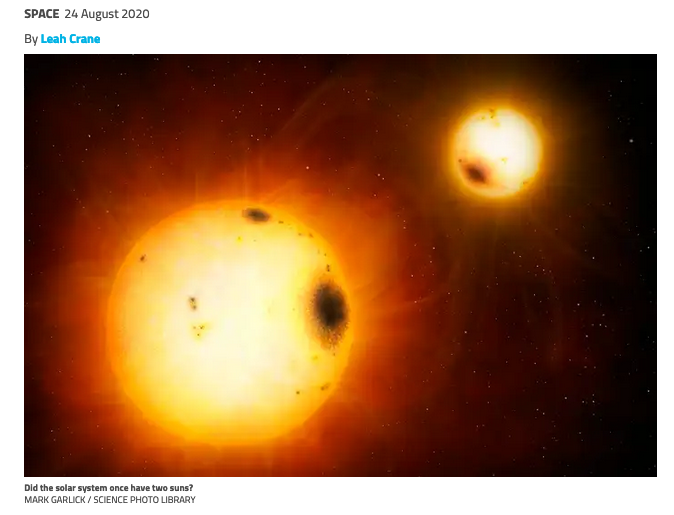
BILLIONS of years ago, there may have been two suns in our solar system. If so, that could explain how the solar system caught its outermost objects, including the hypothetical Planet Nine.
Our solar system is far bigger than just the space occupied by the eight official planets: it extends out to the Oort cloud, a belt of icy objects that sits about 2000 to 100,000 times as far from the sun as Earth does, and is only loosely gravitationally bound to the sun.
How the Oort cloud formed is a mystery, as is the origin of a proposed extra planet that may reside about 500 times as far from the sun as Earth does. Nicknamed Planet Nine, the existence of this world could explain the orbits of certain objects far out in space. Amir Siraj and Avi Loeb at Harvard University have come up with a way to solve both of those mysteries at once.
The sun, like most stars, was almost definitely born in a cluster with many siblings. If it had a companion star orbiting with it billions of years ago, that would have made it much better at catching space rocks like Planet Nine and those in the Oort cloud.
“If the sun had a companion, which is not unusual because more than half of all sun-like stars have a binary companion, that would have produced a very important effect on the solar system because the sun and its companion would act as a sort of fishing net,” says Loeb.
Read more: How Planet Nine may have been exiled to solar system’s edge
He and Siraj calculated that the sun being part of a binary system in its youth, exerting more gravitational pull over a larger area, could increase the chances of our solar system having the sort of Oort cloud we see now by a factor of about five compared with if it has always been a lone star. When it comes to capturing Planet Nine, the likelihood increased by a factor of around 20.
If Planet Nine exists, researchers suspect that it didn’t form where it seems to be now. Instead, it was probably either ejected from the inner solar system shortly after it arose or it was filched from another passing star.
“There is no simple way to make Planet Nine,” says Konstantin Batygin at the California Institute of Technology, one of the researchers who spotted early hints that this distant world may exist. “This is something that could potentially work.”
Read more: Binary stars shred up and shove off their newborn planets
Once the sun and its companion gathered all these objects, the sibling would have been pulled away by another passing star, a process that is common in young star clusters, says Loeb. This would have also blown away most of what was then the Oort cloud, resulting in the relatively sparse belt that we see now.
Evidence for this idea could come from our search for proof of Planet Nine’s existence if we find many other worlds like it in the solar system. “If there was a companion star to the sun, it wouldn’t have just captured one Planet Nine, it would have captured a bunch of those objects just like it captured a lot of Oort cloud objects,” says Loeb. “When I go to the kitchen and find one ant, I know there are more ants walking around.”
Just like those ants are a hint at the state of the kitchen, the objects in the outer solar system could hint at the sun’s distant past and the possibility of a long-lost companion.
